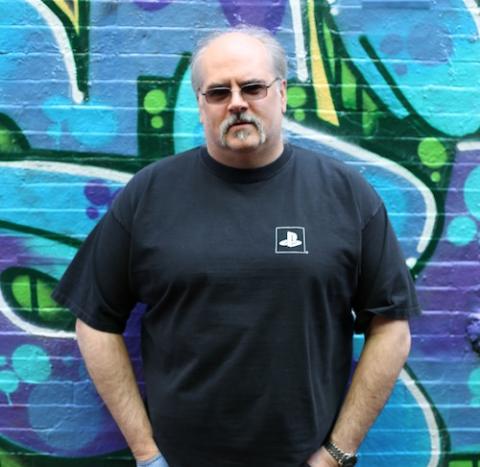Paul “Buzz” Burrowes ’88

Video game audio guru Buzz Burrowes '88
“Music and computers were always my passion,” says Buzz Burrowes, the vice president of online and audio systems and a lead programmer at Harmonix Music Systems Inc. in Cambridge, MA. Those dual interests have led Burrowes to a storied career spanning two decades in the music tech side of video game development at both Harmonix and Sony Computer Entertainment America (SCEA). When Burrowes was hired at SCEA in 1994, the technology needed for high-quality musical scores in games was just emerging. Burrowes played a significant role in its development by creating numerous audio engines that facilitated the progression from simple synth scores to the sweeping orchestral scores now heard in triple-A games.
Growing up in New Jersey, Burrowes says he began as “a closet hacker” working on a Commodore Amiga computer. He also played trumpet in a band. And when the group went into the studio to record a demo, “I was much more interested in what was going on behind the glass than in playing my trumpet,” he says. “So I knew before I got to Berklee that I wanted to major in MP&E.” He arrived at the college in 1984, where he met his wife, Lisa (Togno), also an MP&E major. They got married a few weeks after graduation and set their sights on Southern California.
“At the end of that summer, we loaded everything we owned into a Ford Econoline 150 van and drove to Los Angeles,” Burrowes says. “Then we hit the pavement trying to find work.” In a random “right-place, right-time” scenario, Burrowes landed a job at the famed Record Plant. “I’d sent out résumés to lots of studios, and then followed up by stopping by the Record Plant,” he says. “I was talking to a person at the front desk when the studio manager came in screaming at an intern who had messed up one too many times. She fired him on the spot. Then she turned to me and said, ‘And what do you want?’ I told her I was looking for a job and she said, ‘You’re hired!’” Burrowes’s wife also found a job managing Group IV Recording Studios, a facility recording film scores.
Burrowes worked at the Record Plant starting as a gopher and later as a second engineer for about two years before becoming a freelancer. During his time as a recording engineer, he worked on albums by Bruce Springsteen, Yes, Guns ’n’ Roses, Neil Young, and Bob Seger; and with such producers and engineers as Don Was, Shelly Yakus, and Ed Cherny. He’d also worked on a number of records with Bob Clearmountain who was starting to experiment with QSound, a 3-D sound-processing algorithm developed by QSound Labs. They mixed one album in QSound that never came out, but it put Burrowes on QSound’s radar.
“I got a call from the people at QSound saying they needed a technical rep to teach other engineers to use their tech,” Burrowes says. “I had been thinking about all the sessions where the hours were too long and some of personalities were hard to deal with, and decided that a career making rock records wasn’t what I wanted.” So Burrowes jumped to QSound and spent the next few years traveling to studios around the United States and England working on projects with top artists and engineers.
Burnishing the Chops
In his spare time, he began doubling down on his tech chops. “I convinced the engineers at QSound to send me the source code to the algorithms that ran on the DSP card to make their 3-D sound effect work,” he says. “I looked at ways to make things run faster.” He created a program that drastically reduced the processing time and sent the code to QSound. Subsequently, he began helping with the development of the company’s hardware and software. That led to connections with people in the video-game industry at Sega, Nintendo, and Virgin Games. Three years later, a former QSound colleague who had gone to work at SCEA recommended Burrowes when Sony wanted to build up a first-party software development group.
“The push at the time [1994] was to make video games more like movies,” he says, “and they brought in people from the record and film industries.” With his engineering experience and technical skills, Burrowes was a fit.
He began building their audio department and studio facilities. (By 2009, Sony had a dozen studios in San Francisco, 10 in San Diego, and others in Santa Monica.) Burrowes was coding as well, and wrote the proprietary first-party audio drivers for Sony’s PlayStation 1, 2, and 3 consoles, among other things.
As the audio guru at SCEA, Burrowes ultimately helmed their services group of 50 sound designers, dialog editors, and music supervisors as well as the tools and technology group, another 50-member team writing shared technologies. He was also involved with Sony’s Studio 5 that was building games like SingStar, Lair, and EyeToy: AntiGrav. The titles Frequency, and Amplitude were developed by Harmonix and published by SCEA, which introduced Burrowes to Harmonix staff members. Burrowes was intrigued by their direction and their passion for the work. Harmonix is famous for such music-based games as Rock Band, Chroma, and the original Guitar Hero series.
“I wanted to work with them because everything was musically focused,” he says. “It was a perfect combination for me: music and tech.”
Burrowes was brought onboard in 2009 to help develop corporate strategy at Harmonix. He also works with the company’s CTO Eran Egozy and lead programmers on goals related to software tools. But it’s not all strategy meetings. “I’m currently neck-deep in writing code again for a new music engine,” he says. “Looking back at what I was doing during my earliest days at Sony with PlayStation 1 and where things are now with symphony orchestras and recording in studios all over the world, this has been a fun ride.”



